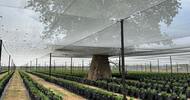Ghana News | Sunday, 3 May 2009
Focusing on satisfying local markets rather than foreign demand may be the best way to start the virtuous circle that farmers need in order to expand, but similar tools are needed for both.
There are a few truths about African agribusiness that tend to undermine the flickers of optimism that followed the hunger riots of 2008. An increase in demand for food, largely but not exclusively driven by rising living standards in Asia, may have exposed global shortfalls in accessible agricultural production, and Africa, with its large untapped potential, has the possibility of providing part of the solution.
Opportunities are being sniffed out by entrepreneurs and governments; from South Korea’s attempt to secure land in Madagascar to swashbuckling capitalists like Philippe Heilberg, who claims to have bought the rights to prime agricultural lands in Nile-irrigated South Sudan.
But just as the International Finance Corporation’s Doing Business report has revealed the progress and obstacles to commercial activity in Africa, so there needs to be a systematic ‘Doing Agribusiness’ review of the barriers to progress in a sector that needs long-term, patient capital to get results.
Most African agriculture is radically split. There is a small group of commercial farmers, but the vast majority are smallholders or subsistence farmers who are vitally dependent on rainfall.
To their credit, governments across the region are realising the value of modernising agriculture as a way of fighting poverty and the importance of moving away from the export of bulk commodities and up the value chain towards processed goods. Once this process is started, a percentage of these ‘improved’ smallholders may evolve more easily into cooperatives that can muscle their way into agribusiness supply chains.
Over the last 15 years, there has been a structural shift in African agribusiness away from the export of bulk commodities and towards the export of horticultural products, higher-value fruits, flowers and vegetables. Getting produce into the supermarkets of the EU and Asia, and to a lesser extent the US, has created a new stream of revenue for countries that previously relied on low-value bulk products.
Producing winter vegetables and citrus for Europe has become an economic mainstay for Morocco, with its ideal microclimates along the coast. Horticulture is now the largest foreign-exchange earner in Kenya , beating tourism and directly employing 2 million people, 80% of whom are smallholder farmers. South Africa exported 2.3m tonnes of fruit in 2008, netting over R10bn $963m).
But horticulture needs a particular environment to thrive in, foremost being a solid and inexpensive logistical base from which to operate. North Africa’s proximity to the EU helps enormously. An added benefit from Kenya’s tourism industry was a fall in airfreight charges, allowing time-sensitive crops like flowers and cut vegetables to be swiftly evacuated.
“You need decent agrologistics,” says commodities consultant Vinay Chand. “The model for the industry is Israel’s Agrexco, which flies five jumbo jets into Frankfurt every week.”
Zambia, which spent a great deal of money in the 1980s setting up an export-orientated horticulture sector, is now suffering from soaring costs. Luke Mbeye, CEO of the Zambian Export Growers’ Association, has seen membership of his organisation drop from 27 to 20. “Farms are closing,” says Mbeye.
“It used to cost $1.50 to export a kilo of produce. That has risen to $2.30, even hitting $2.50 at the peak of the fuel-price hikes.” Stuart Symington, head of the Fresh Produce Exporters Forum in South Africa, believes the industry is losing hundreds of millions of rand a year from poor cold-chain control and congested ports, and yet South Africa’s port system is far ahead of the rest of the continent.
The logic of seeking export markets is not at all clear to Tom Lines, whose book Making Poverty: A history dissects World Bank dictates that pushed countries to focus their energies on creating export industries centred around bulk commodities.
Import substitution to stimulate local markets and focusing on domestic rather than foreign needs is his cure for the current impasse in African agriculture. “Ghanaian farmers should be thinking about what they can sell into Niger, not what they can send to the UK,” he says.
Refocusing on local demand makes sense given the steady growth of African economies over the past decade. Galloping urbanisation and an emergent middle class has created the conditions for the emergence of supermarket chains in South Africa and later East Africa that have implanted themselves in over 20 countries across the continent.
Nigeria, with the largest internal market of 130 million people, has been targeted by multinational food companies, and local agribusiness players like Dangote Sugar and Nigerian Breweries have thrived. The Pick’n’Pay, Massmart, Shoprite, Woolworths (South Africa) and Nakumatt (Kenya) retail chains have created new markets for farmers.
It is here that the potential for linking smallholders to larger agribusiness supply chains is greatest, and here also that smallholders are at the greatest risk of exclusion, unless governments support the extension of services for education, finance, improved inputs and rural infrastructure. In addition, traditionally- neglected areas like packaging, processing, marketing, and phytosanitary and hygiene standards, play a vital part in market access and also create off-farm rural jobs.
Agro-love and devotion
Asian countries devoted a large share of their national budgets to improving yields. African countries, though they have committed to increased spending on agriculture, still lag behind in funding research and development. Senegal is investing $0.91 for every $100 of agricultural produce, according to the International Food Policy Research Institute. Ghana is spending just $0.44, Tanzania $0.38.
Using processors as the missing link between consumers and farmers works. Vitor Philippe, previously a cattle farmer in Gaza Province, Mozambique, was approached by Shoprite in 2001 to open a slaughterhouse to supply its new supermarket in Maputo. With the retailer as anchor client, he expanded and now sells meat to the army and to butchers in the city keen to get better quality meat.
His problems are the same as for agribusinesses everywhere – financing a cold storage room is difficult when there is 19.5% interest on capital investment loans, and his imports of maize for animal feed cost too much, as the local supplier CIM produces low-yielding feed. Nevertheless, he is confident. “This is a cattle producing country originally, and the demand is there,” he says.
According to an OECD report on the potential for agribusiness in Africa, per capita imports of meat, milk and eggs doubled in Tanzania from 2000 to 2005, despite strong growth in domestic egg and milk production.
Another way of linking smallholders to markets is by improving the transparency of prices, which means farmers get more for their produce and can therefore invest more in their productive capacity, creating a virtuous cycle.
The African Commodity Exchange in Malawi hopes to provide just such a service. Founder Phillip Goggin, who also created a similar exchange in Zimbabwe in the 1990s, says that “even if not everyone uses the exchange, the fact that it creates a market means these prices get well known, meaning farmers are no longer accepting any old price from traders who turn up at the farm gate with a bag of money.” A commodities exchange has been set up in Ethiopia and one is planned for Ghana.
Outside North Africa and South Africa, the lucrative next steps on the value chain are still out of reach for large swathes of the continent: semi-processed products like cocoa butter or vegetable oils, and processed products which require industrial transformation, like chocolate, chilled meats or beverages. This is down to the infrastructural challenges still to be met in Africa: poor power supply, roads and ports. Another layer of difficulty: the EU still subsidises agriculture in member states to the tune of $367bn, according to the OECD, while donor support to African agriculture has crashed since 1990.
Finding value in land and crops
Private equity used to stay away from anything to do with agriculture, put off by the uncontrollable risks of bad climate and natural disasters. And yet in the last three years some big funds have been launched in the agribusiness space, and they are busy trying different ways of mitigating the risks. Some want to buy land, while others look to add value to agricultural output.
The private-equity firms buying land work from the bottom up. “We’re buying tractors, buying pivots, building a proper business,” said Paul Christie, marketing director at Emergent Asset Management , which has bought 43,000 hectares of land in South Africa, Zambia, Mozambique and Botswana through its African Agricultural Land Fund. It aims to produce staples such as wheat, maize and soya beans, to rear livestock and make animal feed. It has an asset management arm to hedge its soft commodities on global markets.
Agri-Vie, a South African fund run by Sanlam Private Equity, has chosen to steer clear of primary production. It recently secured a $15 million investment from the African Development Bank to add to its first close of $43 million. “If one focuses on the value-added part of the chain, on processing, marketing, distribution and logistics, then the blend of risks are becoming comparable with most other processing and service businesses,” says Herman Marais, the fund’s managing director.
African agribusiness is well suited to the private equity model of scaling-up for sale back to shareholders or to strategic buyers wanting to secure regional supply chains. Patrick Oketa, chief investment officer at Kampala-based African Agricultural Capital, calls it “patient capital” with little, if anything, to show in the short term, but better returns in the long run.
Some firms that got in early have achieved good returns. Emerging Capital Partners recently doubled its initial investment in SOMDIAA, a sugar, flour and animal-feed producer operating in Cameroon, Chad and Democratic Republic of Congo, by selling the company back to shareholders for $26 million.
Targeting food output for the local market can be a useful bargaining tool with governments when securing land. UK-based Africa-Agri Asset Management plans to launch a $60 million new fund at the end of March to expand on a successful pilot project in Malawi. Its next project involves commercial farms supporting out-grower networks in Mozambique, Sierra Leone and Rwanda. US-based Golden Mean Capital is closing a $10m investment in Ghanaian Cheetah palm oil, providing work for 30,000 out-growers; its co-managing director, William Salva, said local banks were “very eager” to contribute to the debt component.
Nicholas Norbrook, Maputo
Article courtesy of "The Africa Report"
Focusing on satisfying local markets rather than foreign demand may be the best way to start the virtuous circle that farmers need in order to expand, but similar tools are needed for both.
There are a few truths about African agribusiness that tend to undermine the flickers of optimism that followed the hunger riots of 2008. An increase in demand for food, largely but not exclusively driven by rising living standards in Asia, may have exposed global shortfalls in accessible agricultural production, and Africa, with its large untapped potential, has the possibility of providing part of the solution.
Opportunities are being sniffed out by entrepreneurs and governments; from South Korea’s attempt to secure land in Madagascar to swashbuckling capitalists like Philippe Heilberg, who claims to have bought the rights to prime agricultural lands in Nile-irrigated South Sudan.
But just as the International Finance Corporation’s Doing Business report has revealed the progress and obstacles to commercial activity in Africa, so there needs to be a systematic ‘Doing Agribusiness’ review of the barriers to progress in a sector that needs long-term, patient capital to get results.
Most African agriculture is radically split. There is a small group of commercial farmers, but the vast majority are smallholders or subsistence farmers who are vitally dependent on rainfall.
To their credit, governments across the region are realising the value of modernising agriculture as a way of fighting poverty and the importance of moving away from the export of bulk commodities and up the value chain towards processed goods. Once this process is started, a percentage of these ‘improved’ smallholders may evolve more easily into cooperatives that can muscle their way into agribusiness supply chains.
Over the last 15 years, there has been a structural shift in African agribusiness away from the export of bulk commodities and towards the export of horticultural products, higher-value fruits, flowers and vegetables. Getting produce into the supermarkets of the EU and Asia, and to a lesser extent the US, has created a new stream of revenue for countries that previously relied on low-value bulk products.
Producing winter vegetables and citrus for Europe has become an economic mainstay for Morocco, with its ideal microclimates along the coast. Horticulture is now the largest foreign-exchange earner in Kenya , beating tourism and directly employing 2 million people, 80% of whom are smallholder farmers. South Africa exported 2.3m tonnes of fruit in 2008, netting over R10bn $963m).
But horticulture needs a particular environment to thrive in, foremost being a solid and inexpensive logistical base from which to operate. North Africa’s proximity to the EU helps enormously. An added benefit from Kenya’s tourism industry was a fall in airfreight charges, allowing time-sensitive crops like flowers and cut vegetables to be swiftly evacuated.
“You need decent agrologistics,” says commodities consultant Vinay Chand. “The model for the industry is Israel’s Agrexco, which flies five jumbo jets into Frankfurt every week.”
Zambia, which spent a great deal of money in the 1980s setting up an export-orientated horticulture sector, is now suffering from soaring costs. Luke Mbeye, CEO of the Zambian Export Growers’ Association, has seen membership of his organisation drop from 27 to 20. “Farms are closing,” says Mbeye.
“It used to cost $1.50 to export a kilo of produce. That has risen to $2.30, even hitting $2.50 at the peak of the fuel-price hikes.” Stuart Symington, head of the Fresh Produce Exporters Forum in South Africa, believes the industry is losing hundreds of millions of rand a year from poor cold-chain control and congested ports, and yet South Africa’s port system is far ahead of the rest of the continent.
The logic of seeking export markets is not at all clear to Tom Lines, whose book Making Poverty: A history dissects World Bank dictates that pushed countries to focus their energies on creating export industries centred around bulk commodities.
Import substitution to stimulate local markets and focusing on domestic rather than foreign needs is his cure for the current impasse in African agriculture. “Ghanaian farmers should be thinking about what they can sell into Niger, not what they can send to the UK,” he says.
Refocusing on local demand makes sense given the steady growth of African economies over the past decade. Galloping urbanisation and an emergent middle class has created the conditions for the emergence of supermarket chains in South Africa and later East Africa that have implanted themselves in over 20 countries across the continent.
Nigeria, with the largest internal market of 130 million people, has been targeted by multinational food companies, and local agribusiness players like Dangote Sugar and Nigerian Breweries have thrived. The Pick’n’Pay, Massmart, Shoprite, Woolworths (South Africa) and Nakumatt (Kenya) retail chains have created new markets for farmers.
It is here that the potential for linking smallholders to larger agribusiness supply chains is greatest, and here also that smallholders are at the greatest risk of exclusion, unless governments support the extension of services for education, finance, improved inputs and rural infrastructure. In addition, traditionally- neglected areas like packaging, processing, marketing, and phytosanitary and hygiene standards, play a vital part in market access and also create off-farm rural jobs.
Agro-love and devotion
Asian countries devoted a large share of their national budgets to improving yields. African countries, though they have committed to increased spending on agriculture, still lag behind in funding research and development. Senegal is investing $0.91 for every $100 of agricultural produce, according to the International Food Policy Research Institute. Ghana is spending just $0.44, Tanzania $0.38.
Using processors as the missing link between consumers and farmers works. Vitor Philippe, previously a cattle farmer in Gaza Province, Mozambique, was approached by Shoprite in 2001 to open a slaughterhouse to supply its new supermarket in Maputo. With the retailer as anchor client, he expanded and now sells meat to the army and to butchers in the city keen to get better quality meat.
His problems are the same as for agribusinesses everywhere – financing a cold storage room is difficult when there is 19.5% interest on capital investment loans, and his imports of maize for animal feed cost too much, as the local supplier CIM produces low-yielding feed. Nevertheless, he is confident. “This is a cattle producing country originally, and the demand is there,” he says.
According to an OECD report on the potential for agribusiness in Africa, per capita imports of meat, milk and eggs doubled in Tanzania from 2000 to 2005, despite strong growth in domestic egg and milk production.
Another way of linking smallholders to markets is by improving the transparency of prices, which means farmers get more for their produce and can therefore invest more in their productive capacity, creating a virtuous cycle.
The African Commodity Exchange in Malawi hopes to provide just such a service. Founder Phillip Goggin, who also created a similar exchange in Zimbabwe in the 1990s, says that “even if not everyone uses the exchange, the fact that it creates a market means these prices get well known, meaning farmers are no longer accepting any old price from traders who turn up at the farm gate with a bag of money.” A commodities exchange has been set up in Ethiopia and one is planned for Ghana.
Outside North Africa and South Africa, the lucrative next steps on the value chain are still out of reach for large swathes of the continent: semi-processed products like cocoa butter or vegetable oils, and processed products which require industrial transformation, like chocolate, chilled meats or beverages. This is down to the infrastructural challenges still to be met in Africa: poor power supply, roads and ports. Another layer of difficulty: the EU still subsidises agriculture in member states to the tune of $367bn, according to the OECD, while donor support to African agriculture has crashed since 1990.
Finding value in land and crops
Private equity used to stay away from anything to do with agriculture, put off by the uncontrollable risks of bad climate and natural disasters. And yet in the last three years some big funds have been launched in the agribusiness space, and they are busy trying different ways of mitigating the risks. Some want to buy land, while others look to add value to agricultural output.
The private-equity firms buying land work from the bottom up. “We’re buying tractors, buying pivots, building a proper business,” said Paul Christie, marketing director at Emergent Asset Management , which has bought 43,000 hectares of land in South Africa, Zambia, Mozambique and Botswana through its African Agricultural Land Fund. It aims to produce staples such as wheat, maize and soya beans, to rear livestock and make animal feed. It has an asset management arm to hedge its soft commodities on global markets.
Agri-Vie, a South African fund run by Sanlam Private Equity, has chosen to steer clear of primary production. It recently secured a $15 million investment from the African Development Bank to add to its first close of $43 million. “If one focuses on the value-added part of the chain, on processing, marketing, distribution and logistics, then the blend of risks are becoming comparable with most other processing and service businesses,” says Herman Marais, the fund’s managing director.
African agribusiness is well suited to the private equity model of scaling-up for sale back to shareholders or to strategic buyers wanting to secure regional supply chains. Patrick Oketa, chief investment officer at Kampala-based African Agricultural Capital, calls it “patient capital” with little, if anything, to show in the short term, but better returns in the long run.
Some firms that got in early have achieved good returns. Emerging Capital Partners recently doubled its initial investment in SOMDIAA, a sugar, flour and animal-feed producer operating in Cameroon, Chad and Democratic Republic of Congo, by selling the company back to shareholders for $26 million.
Targeting food output for the local market can be a useful bargaining tool with governments when securing land. UK-based Africa-Agri Asset Management plans to launch a $60 million new fund at the end of March to expand on a successful pilot project in Malawi. Its next project involves commercial farms supporting out-grower networks in Mozambique, Sierra Leone and Rwanda. US-based Golden Mean Capital is closing a $10m investment in Ghanaian Cheetah palm oil, providing work for 30,000 out-growers; its co-managing director, William Salva, said local banks were “very eager” to contribute to the debt component.
Nicholas Norbrook, Maputo
Article courtesy of "The Africa Report"













